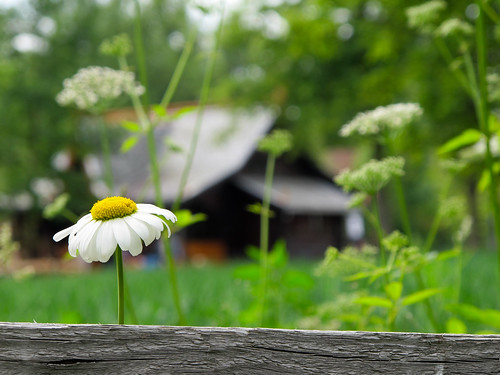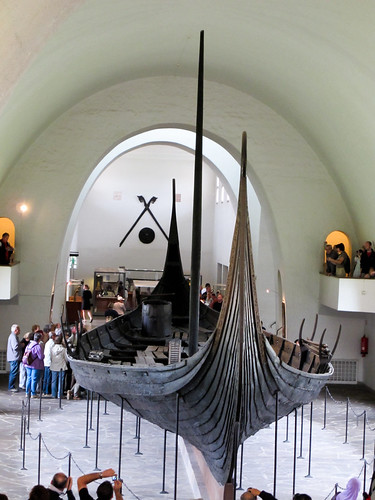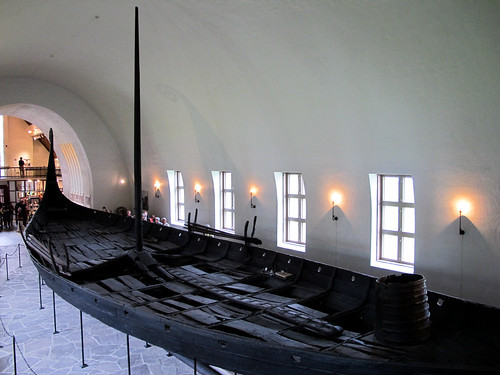The sight that greeted my bleary eyes was a frustrating one. I silently cursed myself for not spending more time taking photos of the city the night before. The previous evening’s blue sky had been replaced by a solid, overcast gray. I sighed. Oh well – nothing to be done about it. I could only hope that it held to the usual coastal pattern: Cloudy mornings burned away by the mid-day sun.
By 10:30 Sten and I were up and ready for our whirlwind tour of Oslo. I’d singled out a few must see points (the Viking Museum and an old Wooden Stave Church) which Sten planned to complement with a local’s insights into the culture and city at large. We set out from the house with a light spring to our step and quickly wound down towards the closest city tram stop. Along the way we paused briefly at a freestanding 7/11 so I could pick up a 1 day tram pass.
Our first stop was the Viking Ship Museum. Located on a peninsula with several other museums, the facility houses three large ships (two of which are mostly intact) as well as several smaller artifacts (carriages, axes, clothing etc.).
The museum houses artifacts from Tune, Gokstad (Sandefjord), Oseberg (Tønsberg) and the Borre mound cemetery. The most obvious of which are the large viking vessels which dominate the museum.
I was particular taken by the artistry evident in the ships’ woodwork. The image above highlights the level of detail and craftsmanship which went into every square inch of the vessels. The sweeping designs, inlaid nails, and carefully aligned planks made it easy to see why the Vikings developed such a powerful reputation as masters of the sea.
I was also somewhat surprised by the ship’s size and openness. While still sizable vessels, it’s an amazing thought to consider that Nordic explorers found their way to the Americas in vessels similar to the one’s I was standing in front of. A trip that even on a modern cruise ship can seem arduous at times. Truly their curiosity, dedication, and toughness was the stuff of legends.
Eventually we wrapped up our exploration of the Viking Ship Museum and set out to find the wooden stave church. The stave churches are a-typical in that their design is completely wooden and has a uniquely Scandinavian appearance. Our search led us down a gorgeous country lane (most of the island is still affluent/residential), before we found a small side path which cut along a fence toward what looked to be a church tower.
The tower itself ended up being a dud (just an odd, modern church) but it set us on the right path. Before long we’d spotted the roof of the stave church, but found our path blocked by a fence. A little more investigation revealed that the church itself sat within the Norsk Folklore Museum. It turned out that the Museum was a sprawling facility with a wide assortment of buildings from Norway’s history which had been dismantled, re-located and re-constructed. In fact the Museum was founded in 1894 and claims over 150 buildings.
We grudgingly paid the entrance fee, not sure what to expect, and then made our way into the compound. It was alive with a wonderful assortment of old/modern buildings, people in period dress, music and small era-centered museum spaces.
The church had originally been built in Gol, the Folklore Museum’s website notes, “The stave church at Gol was built in the 12th century. From the 1600s to early 1800s, the structure went through several renovations and alterations. In the 1870s, however, the congregation had become too large, so the old church was replaced by a new and bigger church.”
I’ve seen a lot of cathedrals over the years and while each one is unique in its own way, the Stave Church from Gol was one of the most unique ones I’ve seen in a long time. From the wooden materials used to build it and the Nordic ornaments on the roof to the unique internal layout, the church stands apart as something that was completely new and different from what I’d seen before. It was small, beautiful and definitely interesting. If you find yourself in Norway, make sure not to miss it!
As we explored the rest of the complex, I was constantly surprised by the a-typical architecture which marked many of the traditional buildings. The stone chimneys were of course to be expected as were the sod/green/live rooftops, but the buildings themselves were often quite unique. Most had the living quarters raised significantly up and off of the ground. Some (like those pictured above) used ladders to gain entrance to tiny doorways, while others (as the building below) featured large earthen ramps met by miniature drawbridges.
The design itself makes sense for a variety of reasons. Small doors to preserve heat which doubled as a defensive measure. A crawl space underneath to house livestock. The small draw bridge to keep the building up out of the snow while also providing an added level of defense/safety, etc. – and yet it was a fascinating design element. One which I’m surprised was never regularly used in the colder regions here in the US.
After an hour or two exploring the exhibits we set off to explore the city proper. Though our route back into the city would be a bit different – Sten explained that our tram pass was also good on the local harbor ferry, which left from somewhere nearby.
The ferry ride was great. The weather was cooperating – the sun had returned – the temperature was perfect, and the view of downtown Oslo from the sea was gorgeous. The City’s town hall is an odd building. It is massive, intense looking and austere in a way which should be ugly, but ends up growing on you. The end result is a memorable building which you can’t quite assign a time period or culture to.
The harbor area itself is great. An eclectic mixture of old and modern buildings with expensive yachts tied-up out front and a long waterfront promenade wrapping around 2/3 of the U-shaped harbor. The walkway is alive with foot traffic, outdoor cafes and bustling restaurants. Add a few outdoor musicians and the 10-15 tall ships (old sailing vessels) tied up nearby and you’re greeted with an absolutely delightful area full of life, history and a constant stream of eye candy.
We disembarked and poked around the old harbor before cutting in a few blocks towards Norway’s Parliament Building. As was the case with the City Hall, the Parliament Building has its own unique feel and style. The building had a very approachable feel, set as it was at the start of a long green which stretch down toward the old National Theater and which eventually ended at the Royal Palace. As is the case with just about any patch of green grass in Norway during summer, the whole area was covered with people relaxing and enjoying the sun. Sunbathers at rest, families eating and even, Sten informed me, a somewhat famous local girl recording a TV piece as she kicked a soccer ball around.
After a quick pause to enjoy the square, architecture and insights into Norwegian culture we began to make our way towards the main market street, pausing briefly along our way when we were approached and harassed by an American missionary. Annoyed, embarrassed and disgusted I rattled off a few quick questions, before we continued or walk.
The main market street was teeming with life and traffic. Every block or so a different street performer had set up shop. From the usual jugglers and musicians to a puppet master, the streets were alive with activity.
Starving we cut down a side street before pausing for lunch at a hip little cafe Sten recommended. The food was good and the view great as we sat on the front patio and watched the locals wander by.
From there it was another quick walk down to the College/Immigrant district, which had an entirely different vibe. Full of music and 2nd hand stores, the area was alive with fun little shops, students and a surprising number of muslim women in burka’s. We interrupted our walk briefly to pause in one of the local park cafes where we grabbed a beer, surrounded by blooming roses, sunbathers, and wandering street musicians before striking off towards our last destination for the day.
Our final stop was Oslo’s new Opera House. The building, located on the harbor, is a beautiful creation. Designed with maritime inspiration, the large blue glass and white marble facility is build on a sweeping angle which slides straight down and into the harbor in an unbroken line. The building which is completely accessible by foot offers fantastic roof top views from the of the city. Its views of the harbor are particularly memorable.
Footsore and tired we decided to head back to the apartment. It had been an incredible day. Truly, Oslo is a delightful city – an experience made that much more memorable by a local’s insights into city culture and history. My thanks to Sten for all he had shared with me throughout our walk.



